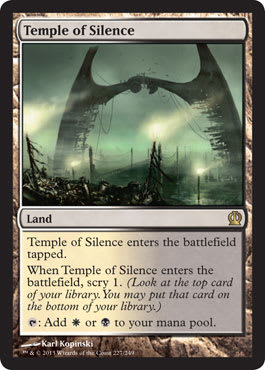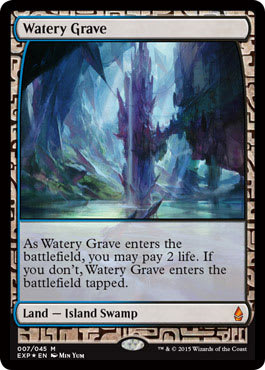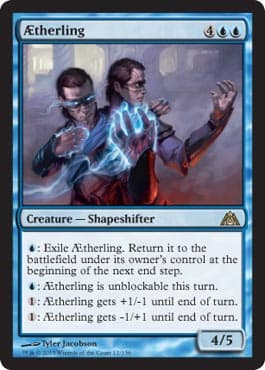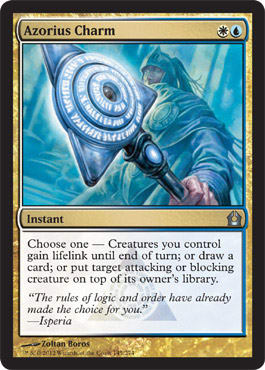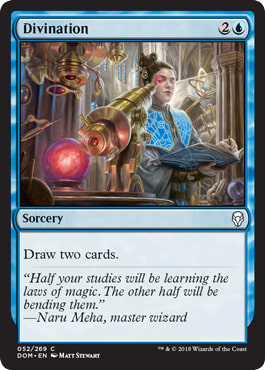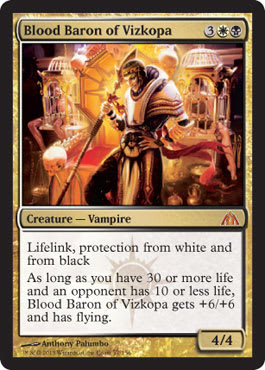As you might know, I didn’t win Grand Prix Dallas/Fort Worth. As you might not know, I didn’t even get to play, despite months of planning.
I, like many others, was a victim of the weather. Living in Austin, I wasn’t affected by the general awfulness of the air traffic conditions (fellow coverage reporter Nate Price might still be trying to get home when you read this), but I was instead bitten by the dreaded my-friends-keep-dropping-out-and-they-canceled-the-hotel-rooms malaise.
It was unfortunate, too, because I’ve actually never felt more prepared for a Grand Prix—or for any tournament at all—than this one. As late as 11:00 P.M. on Friday, I was still searching for a reasonable way to go to the tournament on my own because I had that much faith in my deck. Fortunately/unfortunately, the terrible tales of ice skating on Dallas freeways kept me pinned to my couch and the Modern Masters Drafts in front of me.
My five regular readers (on the generous side) might recall that, in my last article, I proclaimed that I would be playing mono-blue for a whole host of reasons.
Clearly, I am a liar.
Instead, this is what I would have played had I made it to Grand Prix Icepocalypse:
"Esper Control"
- Creatures (1)
- 1 Aetherling
- Planeswalkers (5)
- 1 Elspeth, Sun's Champion
- 4 Jace, Architect of Thought
- Spells (27)
- 1 Doom Blade
- 1 Ultimate Price
- 2 Devour Flesh
- 2 Hero's Downfall
- 3 Azorius Charm
- 3 Dissolve
- 4 Sphinx's Revelation
- 1 Divination
- 2 Thoughtseize
- 4 Supreme Verdict
- 3 Detention Sphere
- 1 Elixir of Immortality
- Lands (27)
- 4 Plains
- 5 Island
- 2 Godless Shrine
- 4 Hallowed Fountain
- 4 Temple of Deceit
- 4 Temple of Silence
- 4 Watery Grave
- Sideboard (15)
- 2 Blood Baron of Vizkopa
- 1 Pithing Needle
- 1 Negate
- 3 Gainsay
- 3 Nightveil Specter
- 3 Soldier of the Pantheon
- 2 Thoughtseize
Briefly, here’s how it happened. I was, in fact, fairly set on playing mono-blue and knew that, beside the sideboard, the deck was pretty much set in stone. Since I had been playing the deck a ton and knew the matchups well, I decided to mess around with Esper in case I changed my mind so I’d have a good build there as well.
Well, despite losing a bunch with Esper, I grew more and more confident with the deck and the specific build. I was beating the decks I wanted to beat and was really only losing to local quirks in the metagame (main-decked Ruric Thar, the Unbowed in green devotion, Rakdos's Return in W/B/R off the top after Thoughtseizeing away anything relevant).
Through all of that testing, I became intimately involved with the deck, grew to love it, and knew exactly what to do in virtually every situation. At some point, I knew it better than any other deck I had worked on.
Moreover, I was winning my “bad” matchups. I wasn’t losing to mono-red or black devotion, and I was keeping my advantages over my good ones. It just felt right. So, at some point the week before the Grand Prix, I decided Esper was my deck even as the weather predictions started to roll in.
I was still kicking numbers around (which I’ll explain shortly), but this was the final iteration of the deck out of something like twelve that I wrote down at one point or another, and this was probably closest to what I would have played.
Let’s go over some of the numbers.
The Land
- 4 Watery Grave
- 4 Hallowed Fountain
- 2 Godless Shrine
- 4 Temple of Deceit
- 4 Temple of Silence
- 5 Island
- 4 Plains
Esper is, at its core, a W/U control deck essentially splashing black for removal and Thoughtseize. As a result, the mana can be a little bit wonky at times, which is technical speak for “bad.”
I knew I wanted several things to be true.
- Nine basic lands – This is both for the sake of my lands coming into play untapped and for fighting Burning Earth. Mono-red decks have been making a comeback, and I had always felt better about my lands with nine no-nonsense basic lands.
- Eight scry lands – One of the primary advantages of Esper over straight W/U is a better ability to play eight scry lands—so much so that some W/U decks and most stock mono-black decks have started “splashing” scry lands just for the scry. These are a must for any control deck, especially in a format in which you’re not sure if you’ll need Doom Blade, Devour Flesh, or Azorius Charm until you sit down to play.
- Four Watery Grave and two Godless Shrine – I had a ton of trouble with my blue mana count. There’s actually no way to get the ratios exactly right without playing Azorius Guildgate, but I couldn’t bring myself to play it.
- Twenty-seven lands – I toyed around with more Divination and fewer lands, but lands were never actually a bad draw, so I kept it high.
That led to the mana base. It is easily the best Esper mana base I’ve played with in this format, and it would be my template moving forward for any further builds.
Actually Winning
This was the most contentious area of the build. I experimented with the finishers nearly every day in the weeks leading up to the Grand Prix. I tried two Aetherling, and I tried two Elspeth, two Blood Baron of Vizkopa, and an Aetherling. I tried three Blood Barons and nothing else. I tried three Elspeth. I tried virtually every combination of Aetherling, Elspeth, and Blood Baron, ranging from two total to five total. Nothing sat quite well with me.
Two Aetherling and one Elspeth was the closest. I wanted very, very few win conditions so I could dedicate all of the other slots to card-draw and removal, so that meant I needed my win conditions to be resilient. Three Blood Baron was surprisingly effective, but you basically conceded Game 1 to control since the Barons just died to Supreme Verdict at some point. And while they were amazing in some matches, they were pretty bad in others. You couldn’t rely on them, especially now that people were packing Devour Flesh in the main regularly.
The epiphany came in two parts. First, I played an Esper mirror match and deftly maneuvered my opponent into a position from which he couldn’t do anything about Aetherling. I resolved it and attempted to go about winning the match. I say “attempted” because I lost, despite him not resolving his own Aetherling for about fifteen turns.
What happened was that my blue mana was constantly tied up while his wasn’t. He could Sphinx's Revelation with impunity while I couldn’t. I could Jace and Elspeth and cast things while occasionally fogging Aetherling, while my mana was constantly busy just keeping up with Aetherling. I lost because he just did other stuff while I messed around with Aetherling.
Part two was when I was testing against a random online deck and he resolved Elixir of Immortality in Game 1 and I just realized I couldn’t possibly win. There were sequences that would let me come out on top, but they all involved him somehow never being able to activate Elixir. Since that wasn’t happening, I was shut out with virtually no effort.
Elixir, it turned out, solved my problem with worrying about losing my win conditions while still keeping the total number of slots low. If I had more time, maybe I would have come to the one-Elixir-and-one-Elspeth configuration employed by William Jensen to make it to the finals with W/U, but the fact is that I was (and still am) probably too in love with Aetherling, despite the signs all being there. Going forward, I can see abandoning Aetherling as Huey did.
The Untouchables
These numbers never changed and never will. This is the core of any W/U control strategy right now, and something drastic would have to happen to alter that.
The Removal
This was the section most in flux as my testing progressed, but I feel I arrived at a pretty good place. The only number I don’t like is the three Detention Sphere, but I had to chop a 3-cost card somewhere (more on this in a moment). If you cut Aetherling, Sphere is probably the first card to come back in.
Beyond that, Azorius Charm is a necessary component, but not so necessary you need to play four in a deck with four other 2-mana removal spells. Straight W/U decks probably want four, but Esper has better options for killing things at 2 mana, and the lifelink mode has never been less useful since we don’t have many creatures.
The black removal package is actually inspired by mono-black, and I think it works pretty well. We can often scry away Doom Blade against black decks, but even then, it can hit Mutavault. Ultimate Price is generally the less useful of the two, but it kills enough Desecration Demons to earn an inclusion. Hero's Downfall would see more copies if it weren’t 3 mana and double-black.
The Rest
- 2 Thoughtseize
- 3 Dissolve
- 1 Divination
I really, really wanted more Divinations, more Thoughtseizes, and fewer Dissolves, but in the end, I came to rest on this. I still want more Divinations, but I am running out of places to cut corners.
So, if I want all of those things, why are the numbers where they are?
With Thoughtseize, I was mostly settled on three for a long time, but the way I was using them wasn’t necessitating that third. I wasn’t usually casting them early, and I was mostly using them as surgical strikes at opportune times rather than as consistently-disruptive spells. They were bad top-decks and virtual blanks in the late game, so I felt okay trimming down to two as long as I made up for it post-board, where I wanted them.
With Dissolve, I tried two for a long time, but I felt behind in control matches (even with three Thoughtseize) and against random things (such as Ruric Thar and Rakdos's Return). Since I knew I would be facing some randomness with no byes, and since I ended up slicing the second Negate from the sideboard, I felt I had to play three. Still not sure that’s correct.
As for Divination, I actually really like the card right now and wish I would have found a way to play more. But since I needed all of the cards that “do” things, Divination was a casualty of trimming down to sixty cards. I think being able to play more Divination is one of the primary advantages straight W/U has over Esper, and it’s something I’ll be watching. The card has really impressed me.
The Sideboard
- 2 Blood Baron of Vizkopa
- 1 Pithing Needle
- 1 Negate
- 3 Gainsay
- 3 Nightveil Specter
- 3 Soldier of the Pantheon
- 2 Thoughtseize
Relative to the rest, the sideboard changed only a little. I always had slots for however many Thoughtseizes I needed to make it to four, and I always had three Gainsay and at least one Negate since they overlap a bit. There were always some number of Blood Barons, though never more than two. And even though it dipped in and out of several sideboards I tried, I knew I wanted at least one Pithing Needle to fight planeswalkers, Mutavaults, and Underworld Connections. Nate Price almost even convinced me to play one in the main.
The odd slots are the Nightveil Specters and copies of Soldier of the Pantheon. Nightveil Specter is, essentially, the slot that would have been occupied in other lists by Sin Collector. Sin Collector has a number of advantages, the most significant of which was that it couldn’t be countered by Gainsay. Specter, however, was better against mono-black and against mono-blue, and it was still crazy-good against other control decks if it resolved. As a bonus, it could even come in against fast red decks just to block all of the 2/2s they have or just negate other Specters. It impressed me at every turn.
Soldier of the Pantheon also bounced in and out of the board, but I knew I had to find space when I lost to Soldier while playing against the mirror. I had kept in very little removal, and the little 2/1 that could just kind of got there. It didn’t go the distance, but it put so much pressure on me that I was in a bad position the rest of the way. Hero's Downfall indeed.
Add in the fact that it was absolutely fantastic against Burning-Tree Emissary decks (better even than I expected), and I was eventually sold on playing three. It was, in fact, the final slot I decided on.
So, that’s what I would have played, and—with maybe one or two different cards—it’s what I would play tomorrow in a heartbeat. I don’t think it has any truly bad matchups, though black, Orzhov, and occasionally red decks can be tough post-board. I think I cracked the Esper code as best as I could before Grand Prix No Clue What a Salt Truck Even Looks Like.
It’s just too bad I didn’t get to find out.














